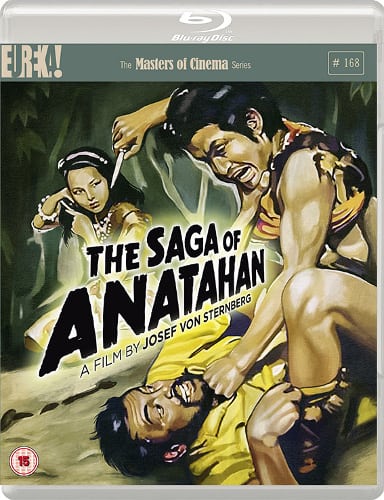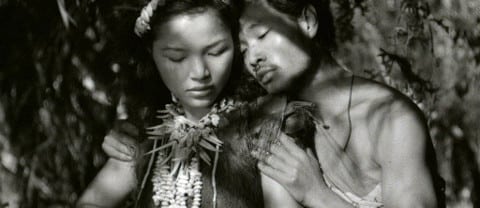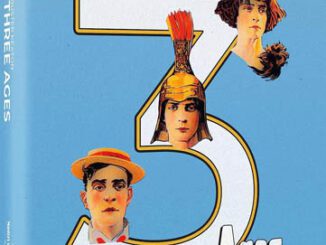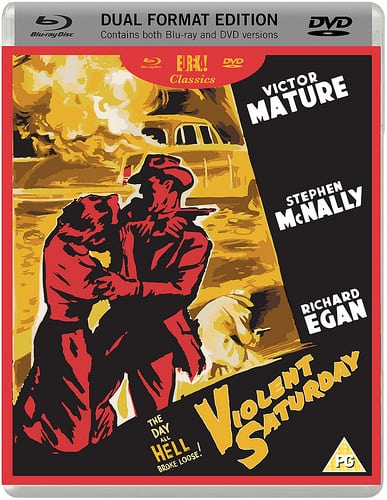The Saga of Anatahan (1953)
Directed by: Josef von Sternberg
Written by: Josef von Sternberg, Michiro Maruyama, Tatsuo Asano, Younghill Kang
Starring: Akemi Negishi, Kisaburo Sawamura, Shôji Nakayama, Tadashi Suganuma
Japan
AVAILABLE ON DUAL FORMAT BLU-RAY AND DVD: NOW, from EUREKA ENTERTAINMENT
RUNNING TIME: 92 mins
REVIEWED BY: Dr Lenera, Official HCF Critic
In 1944 when the tide had turned for the Japanese during the Pacific War, a ship is sunk during an American raid and the twelve survivors shipwrecked on a small island called Anatahan. The only inhabitants seem to be Kusakabe the overseer of the abandoned plantation and Keiko his pretty young wife whom he rules over with an iron hand. Most of the men begin to lust after Keiko who seems to enjoy all this attention, and when the officer in charge suffers a major loss of face, discipline and rationality begin to be replaced by a coconut wine-fuelled struggle for power and Keiko….
Now this is one strange movie that may very well impress and irritate in equal measures but is one that you certainly cannot deny the braveness and ambition of. I guess if I was asked to describe it, it would be as a cross between The Lord Of The Flies and Once Before I Die. When our webmistress Bat happily sent on to me a few screeners because she was getting overloaded and behind with the things, this was the one film that I’d never heard of, though looking at the credits on the IMDB got me a little bit excited because – well, I was certainly familiar with the work of director Josef von Sternberg [best known for his films with Marlene Dietrich] – but it was really because I’m a huge Godzilla fan so to see the names of Eiji Tsuburaya [special effects] and Akira Ifukube [music] immediately got my interest. I was pretty much gripped by the intense drama on display right from the offset despite Sternberg’s heavy use of deliberately obvious artifice. And even if it wasn’t based on true events, it would still be all too believable and not much different if it took place today, because human behaviour never really changes. Unfortunately – well, at least for me anyway though it seems that some regard this film as Sternberg’s masterpiece so it’s something that viewers are probably divided equally on – he not only chose not to subtitle the Japanese dialogue, but also took the peculiar decision to provide almost constant narration of the most heavy handed sort that for me became both irritating and unintentionally funny and which prevented me from getting quite as involved in the drama as I would have been had there been far less narration or none at all – but thankfully there was still alot to enjoy and admire.
It was actually Sternberg’s last film, though the one he made before Jet Pilot was released after. It was Japanese distributor Kawakita Nagamasa who suggested to Sternberg, whose career had virtually come to a halt, that he make a film in Japan. The inspiration was a newspaper article written by a man who was himself stranded on an island with some others for seven years, though Sternberg, who in addition to directing and narrating also wrote and took credit for the cinematography even though that was actually done by Kôzô Okazaki [who agreed that any film from this director was going to look a certain way whowever photographed it], reduced greatly the number of people on the island, totally did away with the island natives, and had everyone living in one area as opposed to being spread out all over it. Making it with an entirely Japanese crew in Kyoto outside the Hollywood studio system allowed him to have total artistic control. It was all shot in an airplane hanger. The film did poor box office in Japan where they would been able to understand the bits of dialogue over which Sternberg wasn’t waffling over [which would have made it quite a different experience] and downright flopped in the US. It was released in Europe with a new narration told by a young Japanese actor and did get great attention in France. Sternberg then tried to recut it so it appealed more and even got Okazaki to add some new shots which were mainly nude ones, but in 1957 gave up and became a teacher at UCLA.
The opening titles are unusual in themselves, all the characters except Kusakabe and Keiko being given names like ‘The Homsick Ones’ and ‘The Queen Bee’ [you can guess who that is], and all cast and crew members only being credited with their last names. The sinking of the ship is simply shown by a globe being superimposed over [probably stock] explosions, there perhaps not having been enough money to build and destroy a model. The survivors make their way onto the island, and the camera pans along the fake vegetation revealing its artificiality with pride. The lack of obvious outdoors footage [except for some shots of the sea] soon begins to create a feeling of claustrophobia which gets more and more stifling as things heat up. Keiko first appears almost camouflaged by the outside of the hut she shares with Kusakabe and the camera pans across the faces of the men, some of them already having obvious feelings of lust, but others not for the time being. Keiko was one character that I could not figure out and still cannot now as I type. She’s in a clearly abusive relationship so probably seeks an escape, but is clearly not very bright if she thinks that trying it on with various soldiers is the best course of action. I guess she’s intended as a kind of archetype, a male fantasy figure, a siren who lures men to their destruction, if not really intentionally. She’s not much different to Sternberg’s Dietrich characters, and it ties in with his favoured theme of men fighting over “ownership” of a woman who seems to reduce members of the three legged species to savagery. I loved the way Keiko moved like a dancer throughout, her every step appearing to be closely choreographed.
Keiko sneaks off to see one particular guy, but Kusakabe finds them and drags Keiko home where he beats her up. However, this is just the start of trouble, with an increasing number of the men becoming interested in her – and I can’t really blame them because actress Akemi Negishi really is a stunner and I thought I recognised her from something – which was nothing less than King Kong Vs Godzilla! They also receive messages stating that the war is over, the Japanese have lost and an American ship will come to pick them up. The proud seamen refuse to believe this though, dismissing it as enemy propaganda, and decide to stay put. It’s not long before even killing is considered a good option just to gain Keiko’s favours. The violence is quick and almost bloodless though there’s a casualness to it that gives it some impact. A rape is artfully suggested by some waving curtains and a brief shot of the nakedv Keiko on the floor. The flashes of nudity – something almost unheard of at the time – include a close-up of Keiko’s [well, it could have been a body double’s] breasts. The whole thing is extremely gripping, unusually filmed with constant barriers like leaves and fabrics preventing us from having a full view of much of the action, and ends in a suprisingly moving fashion when at last we seem to get inside Keiko’s head. The finale does resonate deeply despite the atrocious [and they really are bad, so bad that even Alfred Hitchcock would have rejected them] back projected images behind the characters – though their atrociousness was probably intentional.
The cinema has an honourable history of filmmakers who emphasise the fakery side of filmmaking, but The Saga Of Anatahan just went too far for this critic concerning Sternberg’s narration which apparently from someone who refers to himself as “I” and “we” but who never identifies himself and sometimes admits that no one knows what happened while we watch stuff occur onscreen. Sternberg tells us some of what characters are saying which I guess is fair enough, but he also gives us statements which are bleeding obvious, asks questions, and even informs us of what’s going to happen. Sample lines: “That was the first gunshot on the island. It was not to be the last”. “Obedience at the point of a gun is no obedience at all”. “Who are you combing your hair for”?. “How the day would end, nobody knew at the time”. “Why did man and nature conspire to make us helpless”? As I said earlier, some may not share my views on the narration, but it honestly seemed to me that, far from providing it with the feel of a documentary or challenging us to think about what is real and what isn’t, Sternberg seemed to be trying to sabotage his film and annoy the hell out of the viewer, and after a while I just longed for him to shut up. The next time I watch this movie – and I will watch it again as it does contain much that is good – I may very well turn the sound right down and maybe play some appropriate-seeming music – though then I wouldn’t be able to hear Ifikube’s terrifically moody and evocative score which is almost continuous throughout the picture and which includes a truly moving requiem [set to footage of Japanese soldiers returning home from war] in the composer’s very best style.
Most of the cast members were either non-professionals or Kabuki theatre actors and they all fare very well, adding a real authencity to the proceedings much like the way non-actors appearing in ‘found footage’ films today can enhance the sense of reality. Some of the male characters are treated en masse, understandable perhaps considering their number, but an equal number stand out and have real characters arcs. While I do think that it’s heavily flawed in one very major respect, and I would have appreciated some attempts to get us closer to all the principal characters, there’s a great deal in this highly idiosynchratic picture that does work, and it’s certainly a very potent look at human behavour, the island perhaps being a microcosm of the world which is largely ran on male impulses. And, even if the end result isn’t to your taste, there’s almost always something exciting about a director being left to his own devices and making exactly the film he wants – and not seeming to give a hoot whether you may like it too. If you fancy something totally off the beaten track then give it a go. You may even like the narration.
Eureka Entertainment’s Blu-ray truly shows the brilliance of the cinematography and is also a showcase for how terrific looking black and white can be. Though there’s no commentary track, the set is still pretty comprehensive for a film like this. It ports over all the special features from Kino-Lorber’s Region ‘A’ release and adds an interview with Tony Rayns. I didn’t watch the 1953 version because there’s a short featurette on this disc comparing the scenes which differ. It’s mainly nudity that’s missing from the 1953 version, though are a few other very minor differences. The interview with Rayns lasts 45 minutes and as usual he sometimes goes off on slight tangents and never uses one word when five will do, but his nicely casual talk does maintain interest and delves deeply into background. Most interesting is his description of and showing of a chart where Sternberg mapped out the journeys of the characters during filming. Contrasting very well with this is the half hour look at the film by Tag Gallagher which goes more into the actual picture, what it’s about, how it tells its story, etc.
Saga has Sternberg’s son talk about his memories of his father [who hardly ever talked about his films] and the making of The Saga Of Anatahan. There’s unavoidably some repeated information though this is still valuable as it’s from a different prespective. At one point Sternberg contradicts Rayns – or should that be Rayns contradicts Sternberg as his bit was done after Sternberg’s. They seem at odds as to whether the book Anatahan by one of the survivors, Michiro Maruyama, was published before or after Sternberg had made the film. Then there’s some rather poignant silent footage of the actual survivors being taken back to Japan, and, last but certainly not least, a couple of minutes of some 1958 Okazaki stuff that didn’t make it into the film – which is nearly all footage of Negishi in the buff or close-ups of her breasts. Some of the shots seem to come from a longer version of the rape scene.
A fine treatment of a fascinating, one of a kind, film.
DUAL FORMAT SPECIAL EDITION FEATURES:
*1080p presentation from a new 2K restoration of the uncensored 1958 version of the film
*Uncompressed PCM soundtrack (on the Blu-ray)
*Optional English subtitles
*The complete 1953 version of the film (Blu-ray only)
*A new interview with Asian film expert Tony Rayns
*Whose Saga? – A visual essay by critic Tag Gallagher
*Saga: The Making of Anatahan An interview with Nicolas von Sternberg
*Comparison of 1953 and 1958 versions
*U.S. Navy footage of the actual survivors of Anatahan, immediately after their surrender
*Unused footage originally filmed specially for the 1958 version of the film
*Original theatrical trailer
*PLUS: A booklet featuring a new essay by Philip Kemp, alongside rare archival imagery











Be the first to comment